Plants of little use often have only one common name, or not even that. Plants that are valued or are a pest usually have too many names such Quack Grass.
Most people today know Quack Grass, Elymus repens, as a pest, a hard-to-get-rid of weed found in corn and soybean crops, persistent and resistant to a variety of herbicides. To the Internet population Quack Grass is an herbal medicinal employed as a diuretic. Forgotten between reduced agricultural cash flow and increased urinary flow is Quack Grass as food.
In Edible Wild Plants of Eastern North America, Merritt Fernald, the grand botanical man of his day, wrote: The ubiquitous Quack-Grass or Witch-Grass (with scores of other colloquial names) is usually known merely as a persistent and obnoxious weed, most difficult to eradicate and completely eating up the good of the land; but it was shown in the 18th century that it might be eaten if one cared to utilize it. Thus the British botanist, Withering, wrote: ‘the roots dried and ground to meal have been used to make bread in years of scarcity.'”
Flour from the roots, not exactly what one might expect to learn. Daniel Moerman in his Native American Food Plants mentions seven species used as grain by the natives including E. repens. Also listed were: Elymus canadensis var. candensis, Elymus elymoides, Elymus glaucus, Elymus glaucus ssp. glaucus, Elymus multisetus, and Elymus sibiricus. Dr. Couplan in his Encyclopedia of Edible Plants of North America adds Elymus condensatus, Elymus triticoides, and Elymus canadensis (without the variation.) In Cornucopia II E. canadensis is reported as an important food for the Paiute. It also reports E. triticoides were parched and ground into a fine meal called pinole. It was eaten as porridge or in cakes and drinks. The book also warns that hair on the grain must be singed off before it is used as food. Quack Grass is not a large producer of grain, perhaps only 25 seeds per plant. The starchy root is more attractive from a foraging point of view.
Also called Couch Grass, Quitch, Twitch, Witchgrass and a couple of dozen other common names, it came to North America from Europe around 1818. Botanically, as one might expect, it has has several names: Agropyon repens, Elytrigia repens, Elytrigia vaillantiana, Triticul repens, Triticum vaillantianum, and most recently Elymus repens (EL-ih-mus REP-inns) which understandably translated means Low Growing Wild Millet. Elymus is Dead Latin’s version of an old Greek word for Millet (Elymos) which comes from Elgo which means to cover referring to the lemma and palea which tightly cover the seed. In botanical English it is often referred to as Wild Rye. In Greek mythology Elymus is also the natural son of Anchises and brother of Eryx; one of the Trojans who fled from Troy to Sicily. With the help of Aeneas they built the cities of Aegesta and Elymé. The Trojans who settled in that part of Sicily called themselves Elymi, after Elymus. He was also a man from Lemnos killed by Gorge when the women there killed all the males on the island. I know a family from Lemnos. So the he’s and she’s must have patched things up since then.
Quack Grass seed is some 12% oil and has 3 to 8% triticin, which is related to inulin which might make it suitable for diabetic use. On digestion triticin releases fructose; mucilage (10%); saponins; sugar alcohols (mannitol, inositol, 2% to 3%); essential oil with polyacetylenes or carvone (0.01% to 0.05%); small amounts of vanilloside (vanillin monoglucoside), vanillin, and phenolcarboxylic acids; silicic acid; and silicates.
Green Deane’s “Itemized” Plant Profile: Quack Grass
IDENTIFICATION: Elymus repens: A perennial grass from rhizomes reaching 3 1/2 feet in height. Leaves, 1 1/2 to 12 inches long, very skinny, under 1/2 inch. Blue green leaves may or may not have hairs on the upper surfaces, lower leaf hairless. Short membranous ligule, narrow auricles that clasp the sheath, the quickest and easiest element of identification. Seed head a long, narrow spike with many individual spikelets arranged in two rows along the stem. Spikes 2 to 8 inches long, seeds with awns. To separate it from other grasses look for the auricles, rhizomes, and a long, narrow spike for a seed head.
TIME OF YEAR: Can flower spring to fall.
ENVIRONMENT: Crop fields, turfgrass, lawns, nurseries, moist meadows, urban landscapes, disturbed areas.
METHOD OF PREPARATION: Grain winnowed, singed, used for flour porridge. Roots dried and ground, used like flour.

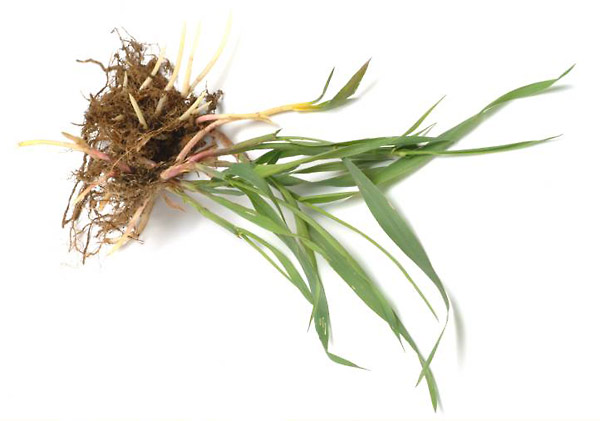
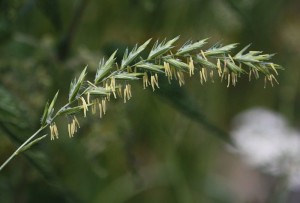
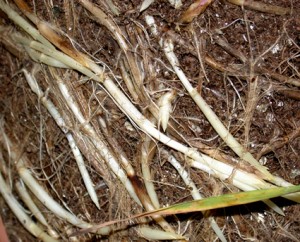
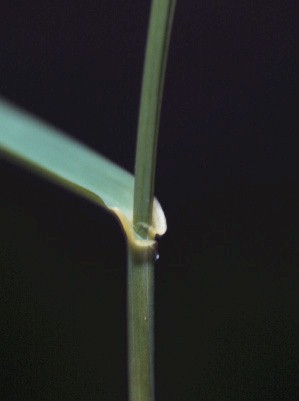
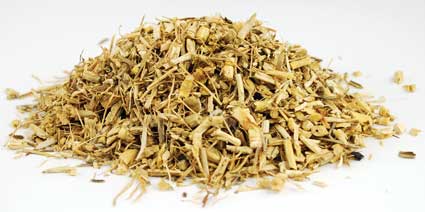

Using it as compost for certain areas in your house or farm can lead to a tragedy of being overrun by this persistent pest. This grass simply doesn’t die once pulled out of the ground.
Thanks for the information. it’s fascinating that you have a Quack/couch grass organization. What do you think about eating it? And if one composts correctly should it also not be deceased rather than still viable?
Using the dreaded Couch grass as compost is still a great debate to a lot of gardeners out there. There are those who simply don’t want to risk the chance of having the grass growing all over their lawn after being made into compost and those who claim that they have to problems with it.
It is not unusual for the forager, the gardener and the lawn keeper to hae different views of the same plant.
Congratulations for the excellent article, another “weed” in my garden has now been spared the trash can! Now if only I could find a way to reserve a designated area for it in my garden….
Have you ever come across a quackgrass beer recipe? I’ve seen them referenced, but haven’t been able to find one.
Hi Laurie ~ While putting together a power point on Couch Grass for an herb class I’m taking, I kept coming across the same references – but no recipe until I found a note from “waljaco” on a Distillers Message Board. He notes there is a Russian Peasant Beer that used Couch Grass called ‘Krest’yanskoye Pivo’ :
“Basically the recipe consists of using the proportion of 1 Russian
bucket or ‘vyedro’ (12 litres or 3 U.S. gals) of water for 2 Russian
pounds or ‘funt’ (approx 2 lb or 918 g) of couch roots. For 6 US gals
(24 l) you need 4 lbs (approx 2 kg) of finely cut couch roots. Soak
them overnight and then boil until they sink to the bottom. This mash
is then sparged by pouring into a tub with a tap, and with its bottom
lined with straw which is weighed down with stones.
Hops and yeast are added. It is bottled with residual sugar for the
secondary fermentation process in the bottles.”
See: http://groups.yahoo.com/group/Distillers/message/4880
I’m also wondering if it could be used in a non-alcoholic “root beer” recipe??
Hope this helps – Barefoot Yankee Gal
Does anyone know where I can purchase Quackgrass seed? I’d like some in my pastures.
Is quackgrass a good horse pasture grass. Is there anything harmful to horses? Does it truly overtake weeds?
Hello,
Where can I buy quack grass seed?
Thanks!
Hey Dean, I hope you will update your article to point out that Elymus is a triticum species and is therefore not safe for people with Celiac disease to consume. Thanks!
I also would like to know where I can order seeds or plants or roots for COUCH GRASS (Elymus repens). I want to grow a large patch for my dogs. It is a very healthy grass for them to nibble on.
every dog or cat that visited my home ended up eating the grass that grew in a particular location; I sent the plants for identification to an expert and learned that they were common quack grass. I now maintain a bed and dig it in the fall, to winter it over in planters under a grow light for my house cats.
It is nearly impossible to purchase; it is classified as an invasive species and rye grass growers do not sell it. (for a time an experimental station at the University of Minnesota grew it to assess its nutritional value for animal forage, but the last experimental work was in the early 2000’s . I found that I had to locate it growing wild and cultivate it from root shoots.
I would like to provide a correction to this page. The pictured seed head (or “seed spike”) is actually NOT Quackgrass (Elymus repens), but rather of an entirely different species, namely Dactylis glomerata (Orchard Grass). I hope you can take the time to change the above picture to one that is more correct than the one you already have to save others the confusion of which is Quackgrass and which is not.
Thank you, and kind regards.
Done… it’s must have been a late night or the like…
Nice article written on my favorite feed for pets and livestock! I have acres and acres of it and have to say I also have a steady population of many forms of wildlife that depend on it. This stuff is tasty and is one of the first things to green up under the snow as winter gives way to warmer weather. Pull up a clump in spring and note that even the earthworms agree it is the best place to go to and live. Love the stuff. Not a weed at all.